Welcome to Saqqara.nl
This website is maintained by the Friends of Saqqara Foundation, a non-profit foundation aimed at providing financial support for Dutch archaeological research at Saqqara, Egypt. For the last fifteen years the foundation has particularly supported the joint excavation team of the National Museum of Antiquities at Leiden, the Museo Egizio at Turin and Leiden University. For several decades, this team has been advancing the research, documentation, and preservation of the monuments in the area to the south of the Step Pyramid of Djoser, where a cemetery of important New Kingdom officials is located.
If you wish to support the Dutch expedition’s excavations and restorations at Saqqara, make an online donation to the Friends of Saqqara Foundation now!
You can transfer your donation to the bank account of the Friends of Saqqara foundation. Our banks details are as follows:
IBAN: NL18 INGB 0009 5621 50
BIC: INGBNL2A
Want to become a Friend?
There are two membership categories:
- Regular, € 35
- Student, € 17,50
(For members abroad an additional € 5 will be charged for postage)
Digging Diary Extra: The Work of the 3D Survey Group
The work of the 3D Survey Group at Saqqara by Francesco Fassi and Alessandro Mandelli
Since 2010 the Milan team has been developing an informative system for the management of the Veneranda Fabbrica del Duomo di Milano, the main cathedral of Milan, based on the 3D survey of the whole monumental building. At the same time, members of the team have been involved in the 3D survey of the archaeological excavation of the underground station ‘Municipio’ in Naples, where photogrammetric survey techniques were thoroughly tested. The 3D Survey Group is also the main research group of the ERC-funded project LIFE (Living In a Fringe Environment), directed by Dr Corinna Rossi, focussing on the interdisciplinary study of the Late Roman settlement of Umm al-Dabadib, located in the Kharga Oasis (Egypt’s Western Desert). The team is now developing a new line of research and investigation focussing on creating an informative system specifically dedicated to archaeological excavations.
The Group’s main task at Saqqara is to survey the concession and the excavation. This may sound like a simple task, but it is done in an innovative and ground-breaking way – providing 3D metric and accurate representations nearly real-time during the excavation, and 2D orthorectified images immediately after the daily fieldwork. All this information is then uploaded into the new Saqqara information system; an extremely useful tool not only during the recording phase in the field but also, at a later stage, to re-elaborate the information, share it with specialists working on the pottery, human remains, wood or architecture in a collaborative environment, and disseminate it to the wider public.
During the first week of work, the existing fixed points to which the topographic survey is tied were double-checked using the expedition’s new total station. Then two separate activities started: the overall 3D survey of the already excavated tombs, and the detailed 3D survey of the area that is being excavated, using photogrammetry for all the different contexts identified.

Fig. 3. Survey of the tomb of Maya
The aim of the general survey of the already excavated tombs is also to fix the absolute and relative position of each monument, previously surveyed independently from one another. By the end of this third week, the Milan team completed the survey of the tombs of Maya (fig. 3), Tia and Tia, Horemheb, Pay and Ray, Meryneith (fig. 4) and Ptahemwia. The photogrammetry has been preliminarily elaborated by our laptops during these afternoons of work back in the dighouse and added to the general survey of the expedition’s excavation area.
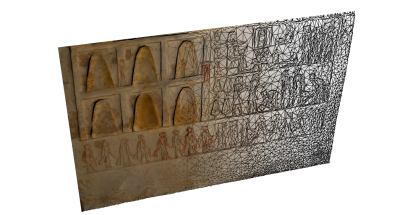
Fig. 4. Scene in the tomb of Meryneith
The photogrammetric survey of the excavated contexts is being carried out with a resolution of 0.5 mm, in order to fully grasp the composition of the various deposits and structures that are being exposed and removed during the fieldwork. Recording the contexts with a 3D georeferenced web-based informative system is a complex and innovative challenge and Francesco, Alessandro and Paolo have been spending long evenings discussing the best and most efficient way to structure the information that is being collected, with the support of the other members of the 3D Survey Group working from Milan. This part of our work is giving us the chance to carry out not only an interesting fieldwork, but also a challenging piece of research on the field together with our colleagues of the Museo Egizio. In this respect, the 3D Survey Group wishes to thank the co-directors of the mission, Dr Christian Greco and Dr Lara Weiss, for the invitation to join their fieldwork, and looks forward to continuing this interesting and fruitful collaboration.
Digging Diary 2: 24-30.03.2018
It’s our third week in Egypt, the second in which we are actually excavating. Miriam is carefully clearing the hill north to our two small Ramesside chapels, in an area that we call the Coptic occupation layer (Fig. 1), i.e. not actually a house, but the remains of some occupation. Particularly interesting was the find of the dump of some workshop materials among which two flint stone knifes, a whetstone and a polishing stone. Underneath the first limestone walls showed. This means we are on our way to Ramesside age. In the meantime, the Milano 3D Survey group has finalized the scan of the tomb of Maya (Fig. 3) and is now continuing with the tomb of Tia and Tia. The results are amazing. Read more about their work next week!
Two scholars from Leiden University joined the team!
Miriam and Sarah have successfully started working at Saqqara. They are specialists on human bones and Egyptian archaeology and material culture. Sarah and Miriam were very happy to accept the invitation by the Leiden-Turin mission to look for a potential cooperation between the museums and the university with the possibility to bring bachelor and master students to Egypt to study the archaeology and material culture of ancient Egypt at such an exciting place! In her role as new assistant professor at the Faculty of Archaeology at Leiden University, Sarah specializes in the analysis of ancient human bones. For the Saqqara excavations she has now started analyzing the bones that were excavated last season (Fig. 2). So far, she has studied several child burials. There are no obvious diseases present on the bones of these children, which may suggest that they died suddenly. Sarah also found evidence for mummification – a plug in the ear of a skull, which appears to be very intentionally placed. Linen was often placed in the ears of the deceased so that evil spirits would not enter the body. Sarah has a lovely workspace in the tomb of Horemheb, where the skeletal material is conveniently stored.
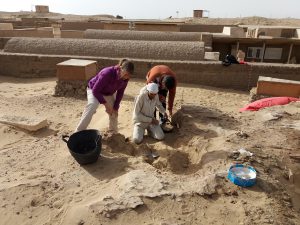
Miriam Müller is carefully clearing the hill north to our two small Ramesside chapels.
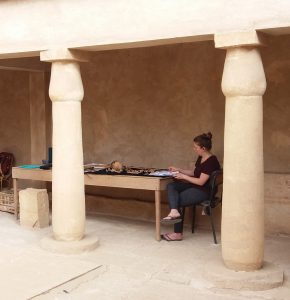
Sarah Schrader in her workspace in the tomb of Horemheb: analyzing human bones excavated last season.
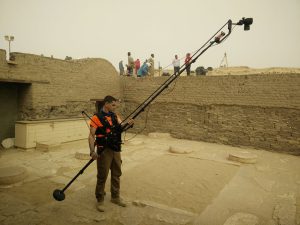
The Milano 3D Survey group has finalized the scan of the tomb of Maya.
Miriam has joined the excavations in her capacity as recently appointed lecturer in Egyptian archaeology, art and material culture at Leiden University. She specializes in household archaeology and the contextualization of finds within their archaeological contexts in order to study behavioral patterns, use and re-appropriation of ancient landscapes the Milano 3D Survey group has finalized the scan of the tomb of Maya a new approach that has also been implemented in the new research agenda of the Saqqara excavations, generously funded by a VIDI grant under the direction of Lara Weiss. Miriam has started documenting an area north of the tomb of Maya, which had yielded dense occupation layers in the previous season. A detailed stratigraphy from the Ramesside use of the area presents itself, in the form of burials with chapels and associated shafts, to the leveling and repurposing of this landscape by probably a Coptic community. The excavations of these layers will hopefully shed more light on the nature of the occupation and use in later periods of this area that was highly significant at the end of the 18th and beginning of the 19th dynasty
Digging Diary 1: 16-23.03.2018
This year the Leiden-Turin team obtained all necessary permissions to excavate in Saqqara at the very last moment. That is why not yet all team members had flown to Egypt: suppose you do not receive permission in the end and have already spent hundreds of euros on tickets…
First in the field were deputy field director Paolo Del Vesco from Turin, our new bone expert from Leiden University, Sarah Schrader, and Lara Weiss from Leiden. We plan to renew our cooperation with Leiden University and soon again bring graduate students with us to Saqqara. A second aim is to set up a research plan and hopefully to invite some PhD students to Saqqara soon. Leiden University Egyptologist Miriam Müller will also soon join the team for the same reason. In addition, two new surveyors of the ‘3D Survey Group’ of the Politecnico di Milanohave started to measure the previously excavated tombs; they will help us to measure and scan the results of the upcoming excavations (fig. 1).
We are looking forward to an exciting season in which the new team hopes to gain a better understanding of the area to the north of the tomb of Maya. This is an area in which the ancient Egyptians built several small chapels in the Ramesside period, and where also later many activities took place. When cleaning the area where we stopped working in 2017 (fig. 2), we already found yet another embalmers’ cache, i.e. a pit used to bury mummification materials. Our most recent cache was found empty, its contents potentially burnt except for two linen bags probably filled with natron. The numerous embalmers’ caches in the area north of Maya’s tomb suggest a post-New Kingdom use of the area as a burial site. This could mean either reuse of existing New Kingdom and earlier tombs, as well as shallow pit burials next to those tombs – such as the body covered by a mat and bead net found by Maarten Raven in his area south of the tomb of Meryneith in 2017 (fig. 3). Sarah has now studied the bones and suggests that it was a young boy or girl of about 15 years of age, who suffered from bad nutrition and illnesses, and who had probably spent his or her life doing hard work, such as carrying heavy bags. We cannot determine whether it is a boy or girl, since the typical female features of the pelvis are not yet identifiable at that young age.
On Saturday we expect to begin with the excavations of the Coptic occupation layer we discovered in 2017, this year supported by household archaeology specialist Miriam Müller. Stay tuned.
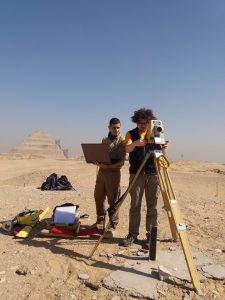
Francesco Fassi and Alessandro Mandelli taking measurements of the excavation field, using our brand new total station.
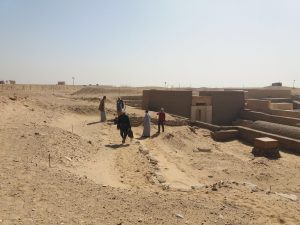
The excavations have just started!
Saqqara Excavation Campaign about to Start
This year it remained uncertain until the last moment whether the Leiden-Turin excavations in Saqqara would continue. At the very last moment, the team got permission from the Egyptian authorities. The excavations can now start on 25 March 2018. This year the team will be working on the New Kingdom cemetery, north of the tomb of Maya and Merit, where two small Ramesside chapels were found in 2017. Field directors of the Dutch-Italian research project are Dr Lara Weiss (curator at the National Museum of Antiquities, Leiden) and Dr Christian Greco (director of the Museo Egizio, Turin).
Save the Dates!
Please save the following two dates in your agenda for our annual events:
16 June 2018 – Sixteenth Saqqara-day
14 November 2018 – Fifth Pubquiz
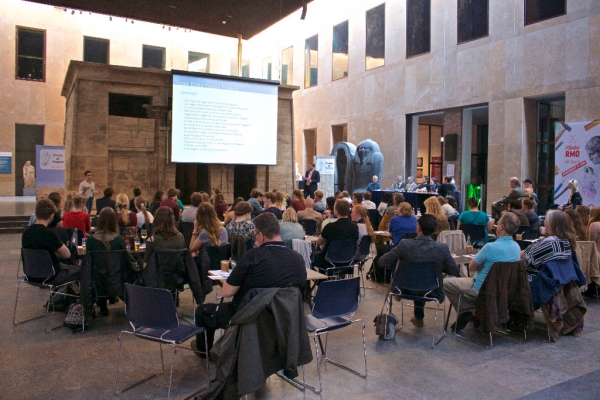
This year we will organize the fifth edition of our Pubquiz!
